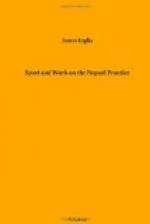A shot on my right, and two shots in rapid succession further on, shewed me that Pat and H. were also at work, and then the whole forest seemed alive with frightened, madly-plunging pig, deer, and other animals. I fired at, and wounded an enormous boar that came rushing past, and now the cries of the coolies in front as they came trooping on, mingled with the shouts of the men at the nets, where the work of death evidently was going on.
It was most exciting while it lasted, but, after all, I do not think it was honest sport. The only apology I could make to myself was, that the deer and pig were far too numerous, and doing immense damage to the crops, and if not thinned out, they would soon have made the growing of any crop whatever an impossibility.
The monkey being a sacred animal, is never molested by the natives, and the damage he does in a night to a crop of wheat or barley is astonishing. Peafowl too are very destructive, and what with these and the ravages of pig, deer, hares, and other plunderers, the poor ryot has to watch many a weary night, to secure any return from his fields.
On rejoining each other at the nets, we found that five deer and two pigs had been killed. Pat had shot a boar and a porcupine, the latter with No. 4 shot. H. accounted for a deer, and I got my buck and the boar which I had wounded in the chest; Mehrman Singh had followed him up and tracked him to the river, where he took refuge among some long swamp reeds. Replying to his call, we went up, and a shot through the head settled the old boar for ever. Our bag was therefore for the first beat, seven deer, four pigs, and a porcupine.
The coolies were now sent away out of the jungle, and on ahead for a mile or so, the nets were coiled up, our ponies regained, and off we set, to take another station. As we went along the river bank, frequently having to force our way through thick jungle, we started ’no end’ of peafowl, and getting down we soon added a couple to the bag. Pat got a fine jack snipe, and I shot a Jheela, a very fine waterfowl with brown plumage, having a strong metallic, coppery lustre on the back, and a steely dark blue breast. The plumage was very thick and glossy, and it proved afterwards to be excellent eating.
Peafowl generally retire to the thickest part of the jungles during the heat of the day, but if you go out very early, when they are slowly wending their way back from the fields, where they have been revelling all night, you can shoot numbers of them. I used to go about twenty or thirty yards into the jungle, and walk slowly along, keeping that distance from the edge. My syce and pony would then walk slowly by the edges of the fields, and when the syce saw a peafowl ahead, making for the jungle, he would shout and try to make it rise. He generally succeeded, and as I was a little in advance and concealed by the jungle, I would get a fine shot as the bird flew overhead. I have shot as many as eight and ten in a morning in this way. I always used No. 4 shot with about 3-1/2 drams of powder.




